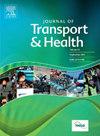Influence of residential self-selection and built environment on walking behavior to grocery stores
IF 3.3
3区 工程技术
Q2 PUBLIC, ENVIRONMENTAL & OCCUPATIONAL HEALTH
引用次数: 0
Abstract
Introduction
While proximity to essential services like grocery stores is widely recognized as a key feature of walkable neighborhoods that support healthy lifestyles, existing research often overlooks the confounding effect of residential self-selection – where individuals choose to live in walkable areas because they already prefer walking. This omission can lead to overestimating the role of the built environment in shaping walking behavior. There remains a critical gap in understanding how much walking behavior is truly influenced by environmental features versus personal preferences. This study investigates the following research questions: (1) What percentage of residents consider walkability important and actually choose to walk to grocery stores? (2) Do individuals who walk perceive their built environments more favorably than those who do not? (3) How does the built environment influence walking behavior when accounting for residential self-selection?
Methods
This study analyzed survey data from 975 respondents in Orlando, Florida, targeting adults aged 18 and above. A structural equation model (SEM) was utilized to examine the factors influencing walking to the grocery store, including socio-demographic characteristics, social influence, perceived built environment, attitudes toward walking, and residential self-selection.
Results
The results revealed that individuals who place higher importance on walkability are more likely to walk to the grocery store. These residents also perceive shorter distances to stores and better sidewalk conditions. Additionally, the study found that socio-demographic characteristics like age, employment status, and car ownership negatively affect walking. In contrast, positive social influence and favorable attitudes towards walking positively impact walking behavior.
Conclusions
This study reveals the impact of residential self-selection and built environments on walking to grocery stores. These insights help policymakers enhance walkability through educational campaigns and infrastructure improvements. By fostering positive social influences and favorable attitudes toward walking, community initiatives can encourage walking, contributing to sustainable and healthier communities.
住宅自我选择与建成环境对前往杂货店步行行为的影响
虽然像杂货店这样的基本服务被广泛认为是支持健康生活方式的步行社区的关键特征,但现有的研究往往忽视了住宅自我选择的混淆效应——个人选择住在步行区域,因为他们已经喜欢步行了。这种遗漏可能导致高估建筑环境在塑造步行行为中的作用。在了解步行行为在多大程度上真正受到环境特征和个人偏好的影响方面,仍然存在一个关键的差距。本研究调查了以下研究问题:(1)有多少比例的居民认为可步行性很重要,并实际选择步行去杂货店?(2)走路的人是否比不走路的人更能感知他们所处的人造环境?(3)在考虑居住自我选择时,建成环境如何影响步行行为?方法本研究分析了佛罗里达州奥兰多市975名受访者的调查数据,调查对象为18岁及以上的成年人。利用结构方程模型(SEM)分析了影响居民步行到杂货店的因素,包括社会人口统计学特征、社会影响、感知建筑环境、步行态度和住宅自我选择。结果显示,那些更重视可步行性的人更有可能步行去杂货店。这些居民还认为到商店的距离更短,人行道条件更好。此外,研究还发现,年龄、就业状况和拥有汽车等社会人口特征会对步行产生负面影响。相反,积极的社会影响和良好的步行态度对步行行为有积极的影响。结论本研究揭示了居住自我选择和建成环境对步行去杂货店的影响。这些见解有助于政策制定者通过教育活动和改善基础设施来提高步行性。通过培养积极的社会影响和对步行的有利态度,社区倡议可以鼓励步行,为可持续和更健康的社区做出贡献。
本文章由计算机程序翻译,如有差异,请以英文原文为准。
求助全文
约1分钟内获得全文
求助全文

 求助内容:
求助内容: 应助结果提醒方式:
应助结果提醒方式:


